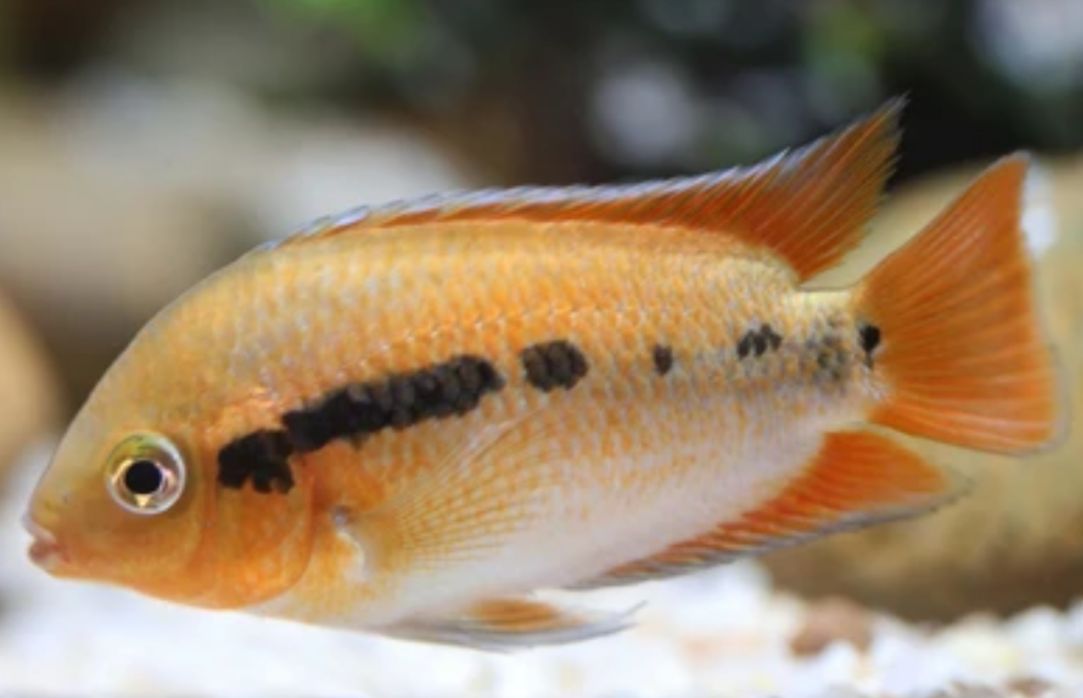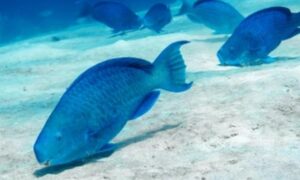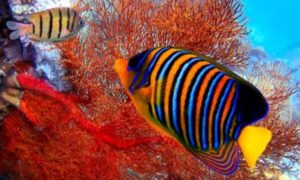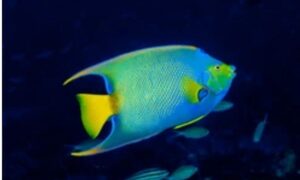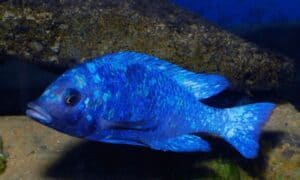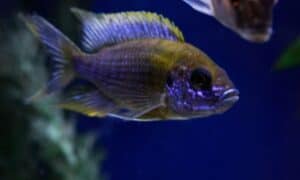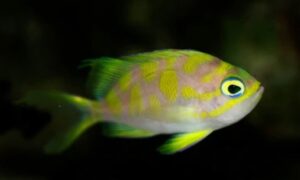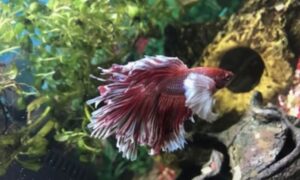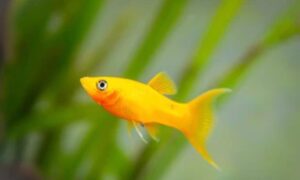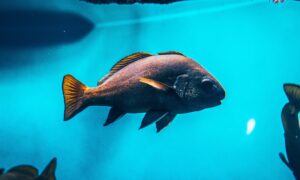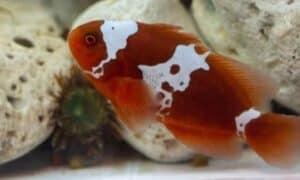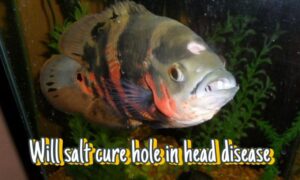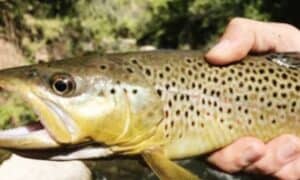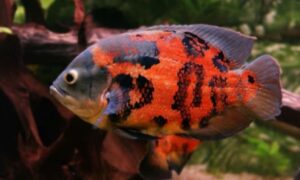Table of Contents
Introduction to cichlids
As from the name, it’s quite obvious that rainbow cichlid comes from the family of cichlids. Cichlids are freshwater fishes and they are quite popular aquarium fishes. They are found in tropical America, mainland Africa, and southern Asia. The most prominent feature of a cichlid is its single nostrils on either side of the fish’s forehead.
Some of the famous cichlids are
- Dogtooth cichlid
- Electric yellow cichlid
- Livingstonii cichlids
- Venustus cichlid
- African butterfly peacock cichlid
- Kenyi cichlid
- Blue neon cichlid
- Rainbow cichlid
- Lemon cichlid
- Sardine cichlid
- Lion head cichlid
Today we are specifically going to talk about one of the most beautiful cichlids which is the Rainbow cichlid.
Introduction to Rainbow Cichlid
Rainbow cichlids can be a very good addition to your tank. They are peaceful fish so they won’t give you much hard time. Rainbow cichlids are known as one of the smallest fish from the cichlid family. The scientific name of Rainbow cichlid is Herotilapia multispinosa.
Rainbow fish can be found in the rivers and lakes of Central America. They are native to Honduras, Nicaragua, and Costa Rica. Rainbow cichlid feed on algae by using their tricuspid teeth. They are found in shallow muddy waters which are rich in vegetation. As I have already mentioned they have tricuspid teeth so they can easily feed on algae.
If Rainbow cichlid is in good condition it can have a lifespan of 7 to 9 years. Rainbow cichlids are quite popular and can be easily found in your local pet stores. These fish cost between $10 and $30 and will happily coexist in a group or a pair of the same species.
The appearance of Rainbow cichlid
As from their name its quite obvious that they are a beautiful colourful fish. They have elongated bodies with pointed dorsal fins. The base colour of their body is muddy brown and yellowish with darker spots. The most unique feature of Rainbow cichlid is that they can change their colours depending on their mood or also they can change during the time of spawning. It takes only a few seconds for them to change colour and they can change colour from yellowish and golden to dark brownish.
If rainbow cichlids are in an aquarium then they will grow up to three or five inches long. But in the wild, they can grow up to seven inches long.
There is not much difference between male and female rainbow cichlids. They both look similar. Male Rainbow cichlids have long bodies, with bright colours and pointed fins. On the other hand, Female Rainbow cichlids have round bodies and their fins are also round. Also, female rainbow cichlids are larger in size than male rainbow cichlids.
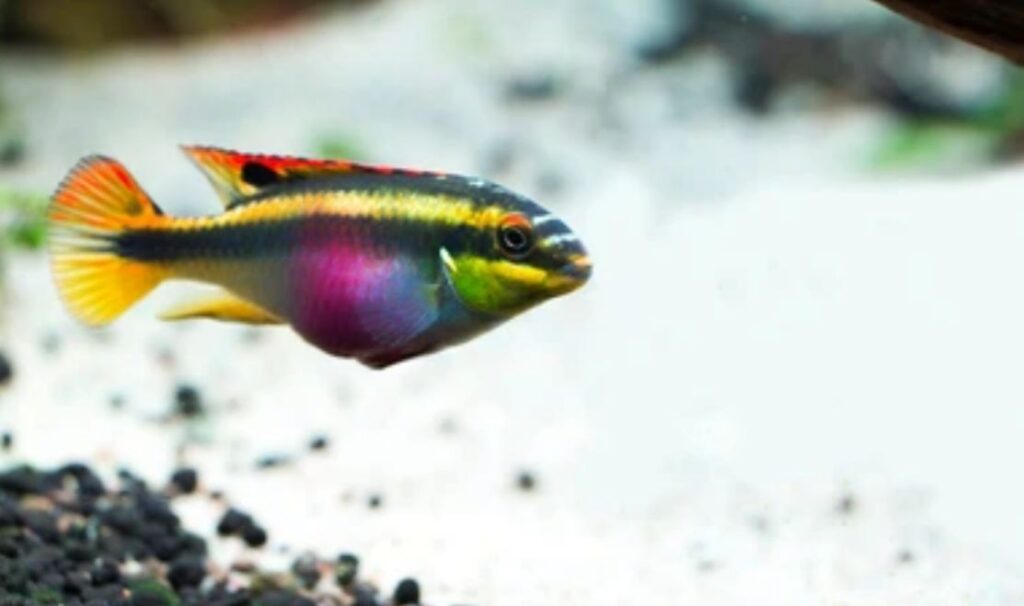
What makes them unique in appearance?
- Their beautiful rainbow colour
- They can change colouration
- They are the smallest cichlid
- They have elongated body
- They have pointed dorsal fins
These points make them special and unique from other cichlids.
The behaviour of Rainbow cichlid
Rainbow cichlids are quite peaceful fish and they don’t give any tough time to its owner. They are a community fish and they are not aggressive at all. If you keep a rainbow fish in your tank then make sure you don’t keep any large fish with them as they might get attacked by the large fish. Keep fish of the same size with them and you are good to go.
When rainbow cichlid feels insecure they hide somewhere in the tank and they change to a pale colour. This is why you should have caves and rocks in your tank so your rainbow cichlid can hide in them when they feel unsafe.
Rainbow cichlid is active swimmers in the daytime. The most unique characteristic that fish experts have told us about is that rainbow cichlids are able to produce sounds underwater, especially during spawning time.
Rainbow cichlid care requirements
Rainbow cichlid is a popular choice among fish keepers because it is very easy to take care of them. They don’t require much effort.
Rainbow cichlid can easily adapt to different environments which is why it is loved by aquarists all over the world.
The most important thing is that they need clean water to survive. So it’s important for you to perform regular water changes so the water is always clean for your Rainbow cichlid. Rainbow cichlid thrives in tank conditions which are the same as their natural habitat. Also, you don’t have to worry about their water temperatures as it’s quite flexible.
They are omnivorous so when it comes to their diet, make sure to provide them with a balanced diet. Their diet should include frozen bloodworms, and meat flakes as these items are rich in protein and also you can feed them with vegetables. In order to keep your rainbow cichlid healthy, you need to have a balanced and healthy diet for them.
Points to remember
- Make sure their tank is clean
- Perform regular water changes
- Make sure the water is clean
- Provide them with a balanced diet
- Don’t overfeed them
Habitat and Tank requirements for Rainbow Cichlid
Natural habitat
It’s better to keep the tank temperature the same as the natural habitat of the Rainbow cichlid. The natural habitat of Rainbow cichlid is muddy rivers, swamps and lakes in Central America. That region is quite hot so it’s quite obvious from this that fishes in that region can handle high water temperatures.
Tank requirements
The ideal situation is to keep the tank temperature similar to its natural habitat. Make sure to have natural plants and a fine substrate in the tank and the water should be warm in order to replicate the natural habitat of rainbow cichlid. The tank size should be 20 gallons for a Rainbow cichlid pair. Community tanks are also good for Rainbow cichlids.
As we have already mentioned above their natural habitat is warm so you should keep the tank temperature warm ranging between 78°F to 82°F. Rainbow cichlid can also adapt to slightly more warm temperatures. They like to have slow water in their tank so I don’t recommend you keep an active water bubbler.
For the cleanliness and maintenance of the tank, you must perform weekly water changes. This will keep the fish safe from disease. During water changes, you can also add a good water filter to keep the water clean. You should also add plants in their tank as rainbow cichlid can hide in them when they feel unsafe also they like to play around with the plants so it’s good to add plants to their tank. Most importantly make sure Rainbow cichlids have enough space to swim freely so don’t occupy your tank with lots of plants or lots of fish.
Points to be noted
- Their tank water temperature should be the same as their natural habitat, so warm water is required for them.
- A 20-gallon tank is appropriate for a rainbow cichlid pair
- Tank temperature should be 78°F to 82°F
- You should have slow water in the tank
- Add plants to the tank
- Keep plenty of space in the tank so rainbow cichlid can swim freely
Do rainbow cichlids become aggressive?
No, they are peaceful fish but during spawning time they can become territorial or slightly aggressive.
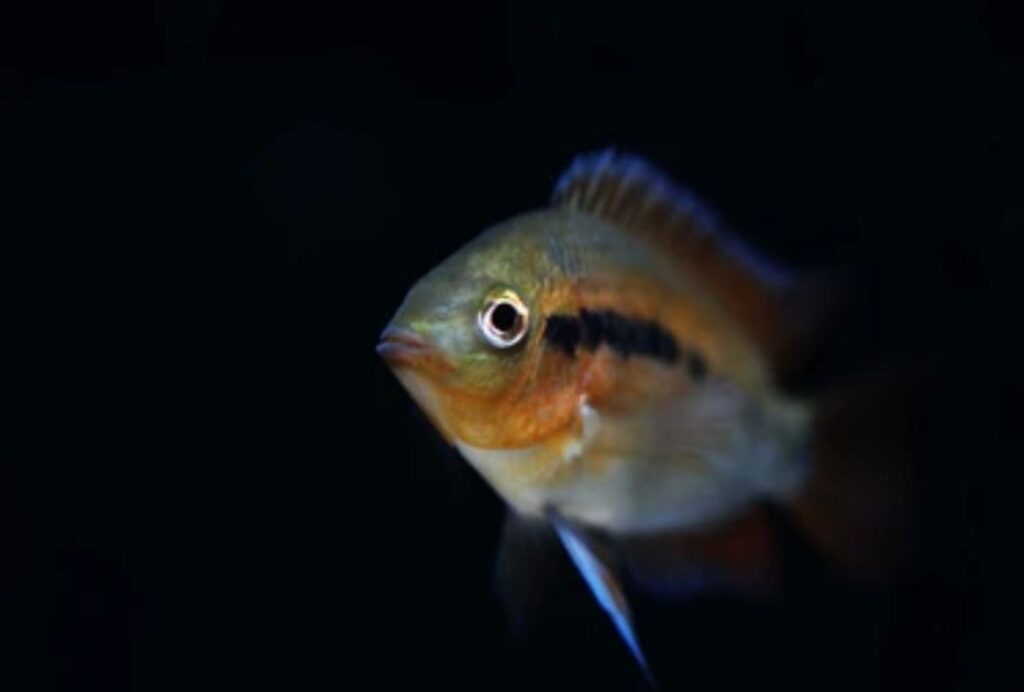
Best tank mates for Rainbow Cichlid
Rainbow cichlid is a peaceful fish and is also very good for community tanks. It gets along really well with other peaceful species.
Some good tank mates for Rainbow cichlid are Catfish, plecostomus and tetras.
The most important factor is that never ever keep any aggressive fish with rainbow cichlids because they are peaceful fishes and they might get bullied by aggressive fishes. They might also get attacked by them so always keep peaceful fishes with Rainbow cichlids.
Points to remember
- Never keep Rainbow cichlids with aggressive fishes
- Rainbow cichlids are good for community tanks
- Don’t keep larger fish with rainbow cichlids
Diet of Rainbow Cichlid
Rainbow cichlid are omnivorous so they can feed on both meat and algae. In the wild, they mostly feed on algae. They eat smaller fish and insects so it’s important to provide them with a protein-rich diet.
Since they are omnivorous so you can feed them both plant-based fish food and animal-based fish food. Some of the best food items for them are frozen bloodworms, brine shrimps, flakes, plankton etc These all items are rich in proteins and are important to keep your fish healthy and happy.
You can also add supplements and vitamins to the water regularly to keep your rainbow cichlid healthy.
You should feed them twice a day by giving them little portions. Don’t overfeed them!!
Points to be noted
- Make sure to give them protein-rich food
- Give them both animal and plant-based food.
- Add supplements to keep your rainbow cichlid healthy
- Never ever overfeed them as overfeeding can cause bloating and digestion issues.
Breeding of Rainbow Cichlid
If you are a beginner fish keeper then don’t worry because breeding of rainbow cichlid is quite easy. Rainbow cichlid easily form pairs.
First of all, buy some healthy young rainbow cichlids and add them to a tank. Now it’s up to them!! They will choose their partners themselves. Once they form their pairs, then feed them with bloodworms, and brine shrimps for a couple of weeks since these food items are rich in proteins and are good for fish health.
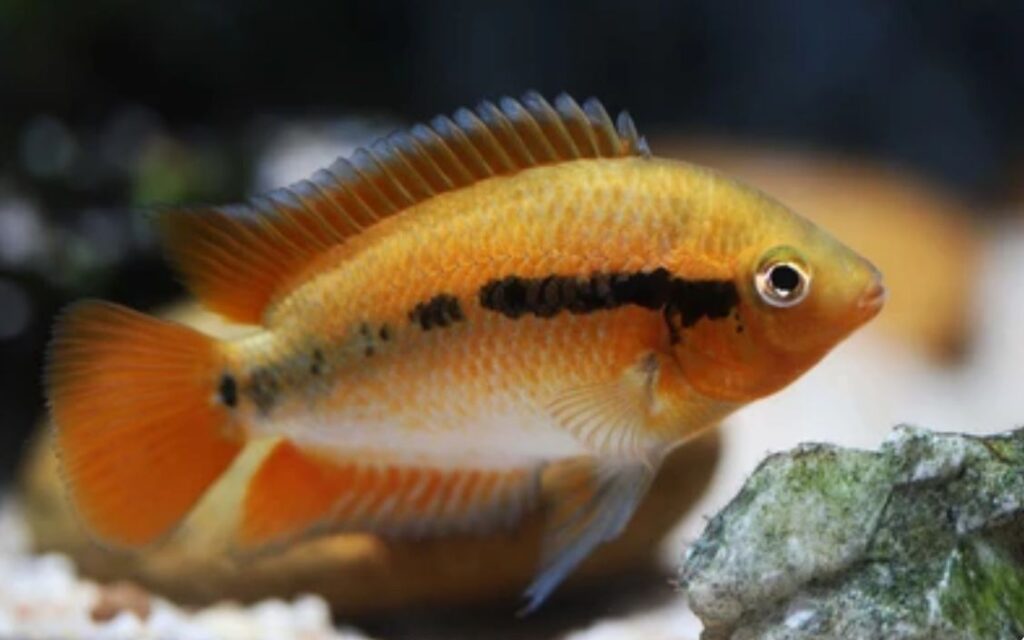
For the next stage, you have to place the pairs in a separate tank which is specially designed for breeding and the spawning process will start.
Now comes the most important stage, the temperature of the water should be higher. It should be about 82°F during the process of spawning. The pH of water also plays an important role and it should be 7.0.
For the surface, you should have a smooth flat stone so the female rainbow cichlid can lay eggs easily.
If you observe your rainbow cichlid changing colour then don’t worry as they do change colour sometimes during spawning.
Once the eggs are hatched, move the parent’s rainbow cichlid to a different tank. You can feed the fry with baby brine shrimp. This is the complete breeding process of rainbow cichlids and it’s quite easy to breed them and even beginners can do it easily!!
Important points to remember
- Make sure the temperature and pH of the water are accurate during the breeding process
- Separate the parents from the fry when the eggs are hatched
- Rainbow cichlids can change colour during spawning and there is nothing to worry about it
Diseases that can occur
Rainbow cichlids are healthy fish and they are not susceptible to any rare or harmful disease. Yeah, they can be common issues if they are not in the right water conditions or if they are not given a balanced diet.
One common problem in them is itching. If you observe small white spots on the body of rainbow cichlid and weird behaviour like loss of appetite or laziness then it means they are getting itchiness.
They can also get affected by bacterial infection if the tank is not clean or if you don’t perform regular water changes. For safety measures, you should quarantine new fish in a separate tank to avoid any harm to other fish.
Is Rainbow Cichlid a good pet?
Yes, they are very good pets. They are easy to take care of and they don’t give any hard time to their owner. They are a great addition to the tank as they are very beautiful and look mesmerizing in your tank.
Their tank requirements are quite simple and when they get plenty of space to swim, they get really happy. Rainbow cichlids are quite popular among fish aquarists since they are adaptable to water conditions. So it’s a great choice to have a rainbow cichlid as your pet.

